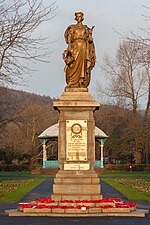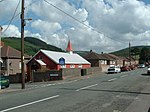Taibach
Communities in Neath Port TalbotFormer wards of Neath Port Talbot
Taibach or Tai-bach (English: Little Houses) is a community and suburban district of Port Talbot, Wales. It is a settlement centered on the main A48 road, sandwiched between the river Ffrwdwyllt and Margam. Parts of Margam are within the community boundaries.
Excerpt from the Wikipedia article Taibach (License: CC BY-SA 3.0, Authors).Taibach
Commercial Road,
Geographical coordinates (GPS) Address Nearby Places Show on map
Geographical coordinates (GPS)
| Latitude | Longitude |
|---|---|
| N 51.584 ° | E -3.769 ° |
Address
Heol Masnachol / Commercial Road
Commercial Road
SA13 1LP , Taibach
Wales, United Kingdom
Open on Google Maps







